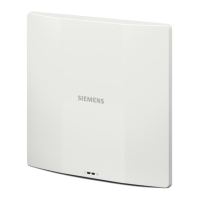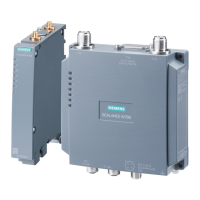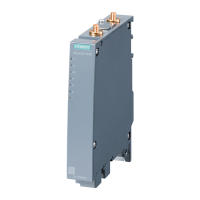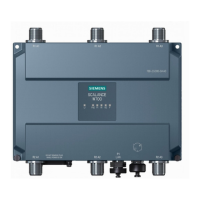Roles and Policies
15.1 Firewall Policies
SCALANCE W1750D UI
Configuration Manual, 02/2018, C79000-G8976-C451-02
247
(scalance)(Access Rule "employee")# rule 192.0.2.2 255.255.255.0 match 6 631 631
permit
(scalance)(Access Rule "employee")# rule 192.0.2.8 255.255.255.255 invert 6 21 21
deny
(scalance)(Access Rule "employee")# rule 192.0.2.1 255.255.255.0 invert 17 67 69 deny
(scalance)(Access Rule "employee")# end
(scalance)# commit apply
Configuring Network Address Translation Rules
Network Address Translation (NAT) is the process of modifying network address information
when packets pass through a routing device. The routing device acts as an agent between
the public (the Internet) and the private (local network), which allows translation of private
network IP addresses to a public address space.
SCALANCE W supports the NAT mechanism to allow a routing device to use the translation
tables for mapping the private addresses into a single IP address. When packets are sent
from this address, they appear to originate from the routing device. Similarly, if packets are
sent to the private IP address, the destination address is translated as per the information
stored in the translation tables of the routing device.
Configuring a Source-NAT Access Rule
The source-NAT action in access rules allows the user to override the routing profile entries.
For example, when a routing profile is configured to use 0.0.0.0/0, the client traffic in L3
mode access on an SSID destined to the corporate network is sent to the tunnel. When an
access rule is configured with
action, the users can specify the service,
protocol, or destination to which the source-NAT is applied.
You can also configure source-based routing to allow client traffic on one SSID to reach the
Internet through the corporate network, while the other SSID can be used as an alternate
uplink. You can create an access rule to perform source-NAT by using the SCALANCE W UI
or the CLI.
To configure a source-NAT access rule:
1. Navigate to the WLAN wizard or the Wired settings window:
–
To configure access rules for a WLAN SSID, in the
tab, click
to create a
new network profile or click
to modify an existing profile.
– To configure access rules for a wired profile,
. In the
window,
click
under
to create a new network or click
to select an
existing profile.
2. Click the
tab.
3. To configure access rules for the network, move the slider to the
access
control type. To configure access rules for user roles, move the slider to the
access control type.

